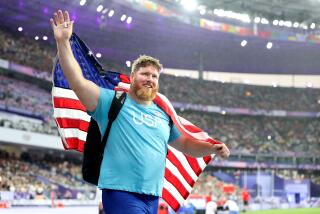Al Oerter, 71; discus thrower won gold medals in four consecutive Games
- Share via
Al Oerter, one of only two track and field competitors to win gold medals in the same event in four consecutive Olympic Games, died Monday of heart failure at a hospital near his home in Fort Myers, Fla. He was 71.
While Carl Lewis also won four straight Olympic gold medals, Oerter did Lewis one better. Oerter not only won four gold medals in the discus event, he also set Olympic records in the 1956, 1960, 1964 and 1968 Games.
“His legacy is one of an athlete who embodied all of the positive attributes associated with being an Olympian,” said Peter Ueberroth, chairman of the U.S. Olympic Committee.
Oerter had suffered from high blood pressure most of his life, and in 2003 he collapsed and briefly stopped breathing. Doctors suggested Oerter undergo a heart transplant operation, but he refused.
“I just flat out can’t see it,” Oerter told reporters. “Just can’t see it. I’m not going to get a new heart.”
Oerter was born Aug. 19, 1936, in Astoria, N.Y. He threw the lighter disc used by high school athletes 184 feet, 2 inches to set a prep record and put himself under the athletic spotlight. He went to the University of Kansas and immediately set an NCAA record, but when he went to the 1956 Olympics in Melbourne, Australia, after his sophomore year at Kansas, he had never competed in a major international competition.
At his peak, Oerter was 6 feet 4 and weighed 297 pounds, measurements that weren’t extraordinary for discus throwers. In his first Olympic throw in 1956, Oerter’s discus traveled 184 feet, 11 inches. It was the winning mark.
Never shy, Oerter bragged after his first gold medal, “I’m not going to quit until I win five gold medals.”
Four years later, in Rome, Oerter won in a different way, coming from behind. At the Olympic trials, Oerter was beaten by Richard “Rink” Babka, who held the world record at the time. Going into the last throwing round of the finals in Rome, Babka had a 15-inch lead on Oerter. On his final throw, though, Oerter launched the discus 194-2, not only an Olympic record but also a personal best for Oerter. Babka couldn’t match the distance on his final throw.
Less than a week before the 1964 Games in Tokyo, Oerter tore rib cartilage and doctors suggested he wait six weeks before throwing to avoid internal bleeding. Oerter went to the Olympics instead. In the preliminary round he set another Olympic record with a throw of 198-8. In the finals, Oerter was struggling with pain and in third place going into his final throw. Spinning more slowly than anyone had ever seen him, Oerter somehow cracked off a distance of 200-1, yet another Olympic record.
Next came the 1968 Olympics in Mexico City, where Oerter was the 32-year-old underdog to his own U.S. teammate and the world record holder, Jay Silvester. In the high, thin air of Mexico City, Oerter threw a personal best of 212-6 to earn his final gold medal.
Oerter came out of retirement at the age of 43 in 1980 and qualified as the U.S. alternate for the team that boycotted the Moscow Olympics. That year he threw 227-11, his career best and the second best mark of the year. Oerter also competed at the 1984 Olympic trials, where he made the finals before pulling out because of a calf muscle tear.
After his track career, Oerter worked as a computer specialist for Grumman Aircraft Corp. and as a representative for Reebok. He lived on Long Island in summer and in Florida in winter.
In 1980 Anheuser Busch commissioned several Olympians, including Oerter, to create works of art involving each one’s athletic pursuit. Oerter used the discus by flinging it at pools of paint on a canvas.
Oerter found this pastime so engaging that he helped start a program called Art of the Olympians. With works collected from Olympic athletes such as long jumper Bob Beamon and luger Cammy Myler, the exhibit travels around the country. Oerter had hoped to find it a permanent gallery in Fort Myers.
For the last 25 years Oerter was an outspoken critic of drug use in athletics. He gave speeches in which he often said: “What sense do you have of yourself when you’re cheating? It can’t make you feel good. Why would you do that? Develop some self-esteem. Not say that I’m a cheater and know how to beat the system.”
When he was inducted into the U.S. Track and Field Hall of Fame, Oerter was asked to describe his feelings about his four gold medals. “The first,” he said, “would be the most surprising, the second the most difficult, the third the most painful, the fourth the most satisfying.”
He is survived by his second wife, the former Cathy Carroll, who was an international-class long jumper; and two daughters from his first marriage, Crystiana Beardslee of Mexico, N.Y., and Gabrielle Oerter of Colorado Springs, Colo. Funeral arrangements are pending.
--
More to Read
Go beyond the scoreboard
Get the latest on L.A.'s teams in the daily Sports Report newsletter.
You may occasionally receive promotional content from the Los Angeles Times.






